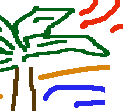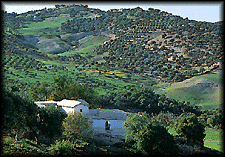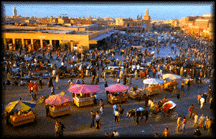
 |
Middle East International Services | Commerce | Almusaafer | Higher Education |
| Language Services | Arabic Course | Resource Center | ||
 Marrakesh Attractions
Marrakesh Attractions
Press to go back to:
[Marrakesh Sightseeing Index]
[Morocco Sightseeing Index]
[Moroccan Index]
To leave Morocco press:
[Country Search]
[Home Page]

NOT TO BE MISSED...
Tangia: The Best of Tradition. It is both the name of a rounded earthenware pot and a delicious dish of mutton and spices which stews slowly, buried overnight in hot ashes. Delectable!
The Tanners Ancient Craft: Nothing has changed in the souk's tanneries for many hundreds of years. Among the skins stretched out on the straw to dry in the sun, close to the vats, craftsmen are still using saffron to obtain yellow, poppies for red, indigo for blue and antimony for black. A look into the past that should not be missed.
Your Carriage Awaits for the Palmeraie: As the horse settles into a brisk trot, how delightful it is to feel the gentle caress of the light breeze on your cheek and gaze at the silhouette of the palm trees standing out against the fiery sky; riding towards the tower of the palm grove in the light of the setting sun is one of the most romantic moments you can enjoy in Marrakesh.
Marrakesh, City of Fascination Carts overflowing with oranges and roasted grains, women from the Anti-Atlas coming to sell their baskets, storytellers, musicians, dancers, public scribes with their black umbrellas, fortunetellers, potion vendors, healers and apothecaries all contribute to the unreal spectacle that, in Marrakesh, is commonplace.
Then, as dusk approaches, the showmen make way for the hot food stalls. One after another, acetylene flames spring into life. And then, in the starry night, the moon comes out to play the role it was designed for: to be the most magical of the thousand and one lanterns lighting up the Jemaa el Fna Square.
Marrakesh awakens. Just as it has done every morning for more than 800 years, with the same inflected intonation, the call of the muezzin going out from the 70 meter high Koutoubia, the spiritual beacon of Marrakesh.
 | Sunrise over Marrakesh. A multicolored crowd invades the winding streets of the medina. Groups of men jostle towards the Ben Youssef mosque, nestling against the Medersa, the vast and superb Koranic school founded by the Merinde sultan Abou el-Hassan (1331 - 1349) and one of Marrakech's most remarkable monuments. |
The sun bathes Marrakesh in light. Its rays show up the pink marble of the fountains, spread across the tiled courtyards, are reflected and than bring warmth to the turquoise, greens and whites of the mosaic, to finally be lost amidst the stucco of the Bahia Palace and the Dar Si Said, now a museum housing the finest masterpieces of Moroccan art. The legendary sun of Marrakesh adds a note of accentuated contrast to the imperious splendor of the Saadian tombs. It illuminates the remains of the Badii Palace where a shimmering mirage may reveal the wonder of these former glories to the dazzled visitor; the gold, the marble and the onyx which were traded for their weight in sugar by the most celebrated Saadian ruler, Ahmed el Mansour (1578 - 1603),
The sun sets over Marrakesh. Then, against a sky blazing with evening fire bounded by the eternal snows of the Atlas mountains, the perfect proportions of the Menara pavilion may be contemplated, mirrored in the quiet, still waters that stand before it.
Time had passed you by. In the copper souk perhaps, where the metal is worked by craftsmen following age-old traditions, their faces set in profound concentration. Or perhaps it was in the Laghzal Souk, home of the wool merchants. Or in el Btana with its sheepskins. Or even in the hubbub of the Zarbia souk, where carpets and caftans are sold to the highest bidder.
You are in another world. Where the smell of saffron,cumin, black pepper, ginger, verbena, cloves and orange flower enchant the nostrils. Among sacks of almonds, ground nuts and chick peas piled high like mountains, with baskets of dates, casks of olives and, on the apothecaries' shelves, pots of henna, ghassoul, flasks of rose extract, jasmine, mint, khole, pieces of amber and musk...
You are in the souks of Marrakesh.
Outside the Ramparts...
Outside the ochre-colored ramparts, the rhythm is broken, the colors change. The sound of the wind in the foliage, chirping birds, the heady odors of jasmine and honeysuckle and the persistent perfume of the famous Marrakech roses. Here, nature is a haven of peace, beauty and contemplation. No doubt it is grateful to man for having watered it since 1106 by means of an ingenious system of collecting and channeling spring water. 13,000 hectares of vegetation, 180,000 palm trees, a world class golf course; this is renowned Palmeraie (Palm Grove) of Marrakesh. Further away, behind the Royal Palace, stretch the Agdal orchards, the setting for lavish festivals and celebrations. The trees weigh themselves down with exquisite fruit as the seasons advance; oranges, figs, pomegranates and olives...And near Bab Doukkala stands the Majorelle garden with its abundance of giant bamboo, yucca, papyrus, palm, cypress and banana trees, philodendrons and bougainvillea's, and amazing cacti with natural colors that contrast vividly with the bright blue facade of the villa.The Wonders of the Atlas Mountains
Seen from Marrakesh, the vast, imposing mass of snow-capped mountains seems unreal and unbelievable. And yet the splendor, other-worldliness and imposing might of the constantly changing Atlas landscape are only 20 kilometers away. Just head out South East of Marrakesh, through the friendly Berber villages of Aghmat and Dar Caid Ouriki. Follow the road bordered with terraced gardens along Wadi Ourika until you reach Arhbalou. From there on, the choice is simply limitless!Bear right towards Oukaimeden (2,600m), the famous winter sports resort only 74 km from Marrakesh. Or else admire Setti Fatma and its hundred-year-old walnut trees and dive into the invigorating coolness of its seven waterfalls. Or possibly go on to Annameure, village of the Ait Oucheg tribe where you can hire a mule and climb up as far as Djebel Yagour, center of Moroccan prehistory which boasts over 2,000 cave paintings.
To the South, another change of scene. 47 km from Marrakesh, on the road to Taroudannt, in the typically Berber village of Ansi, people come to barter in the souk which is held every Saturday. Towards Ouirgane, the landscape is reminiscent of American canyons. Magnificent gorges lead to Imlil, a charming mountain hamlet. This is the starting point for hikes through Toubkal national park: climbing to the summit (4165 m), North Africa's highest point or, at 3,800 m, the Tazaghaght plateau, a stone strewn desert as such an altitude that it looks down upon the clouds.
East of Marrakesh, water, water, everywhere! The Ouzoud Falls, where the water plunges for more than 100 meters. Wadi Mehasseur, spanned by the natural Imi-n-Ifri bridge, the "gateway to the abyss" in Berber, which cascades through vast rock formations to end in the artificial Ait-Aadel lake surrounded by bare, red-colored hills.
Popular Art: A Genuine Festival!
Every year, the ruins of the el Badii palace provide the grandiose setting for the national festival of popular art. This is the showplace for music, dance and songs, costumes, jewelry and ornaments for family or religious celebrations. Quite enchanting!